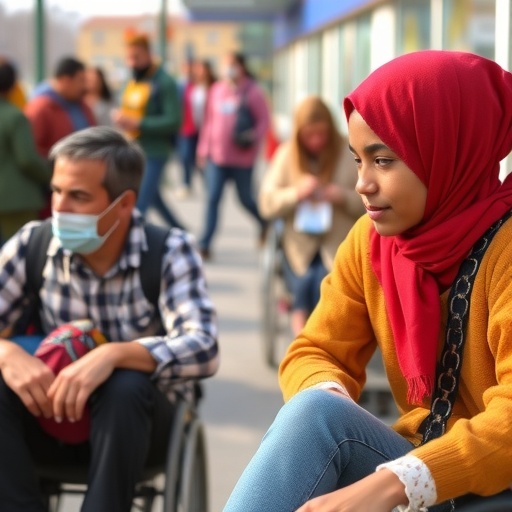A landmark investigation into the health outcomes of over five million older Americans has unveiled a compelling new dimension to the understanding of longevity and quality of life in later years. The extensive study reveals that individuals who migrate within the United States tend to experience markedly better health outcomes compared to their counterparts who remain in their state of birth. This finding illuminates the existence of a nuanced “healthy migrant effect” operating not just across international borders but within the internal geography of high-income countries like the U.S.
Published in the Journal of Ethnic and Migration Studies, this expansive observational analysis dives deep into the prevalence of five specific types of disability among Americans aged 65 and older. These include serious vision impairment, hearing loss, cognitive deterioration, limitations in activities of daily living (ADLs), and physical mobility challenges such as difficulties in walking or climbing stairs. The sheer scale of the study—tracking 5.4 million individuals—lends unprecedented statistical power and reliability to the conclusions.
What stands out most strikingly is the consistent pattern of healthier outcomes reported by older adults who have moved away from their natal states. This internal migrant group exhibited significantly lower odds of experiencing all five disabilities compared to their non-migrant peers. Even after rigorous adjustments for confounding factors like age, sex, and race, the disparity remained substantial, with non-migrants facing up to a 22% increase in the likelihood of disability.
Such findings raise important questions about the mechanisms underpinning this internal migration-associated health advantage. Coauthor Katherine Ahlin, a graduate of the Factor-Inwentash Faculty of Social Work at the University of Toronto, highlights the novelty of the evidence: “This is the first large-scale confirmation that moving states within the U.S. correlates with superior health outcomes in older adults.” This insight challenges the simplistic stereotypes often associated with mobility in senior populations, suggesting a complex interplay of socio-economic and behavioral factors.
A critical part of the analysis involved disentangling the role of educational attainment. Controlling for education reduced but did not fully eliminate the health benefits observed among internal migrants. This indicates that while higher education—often linked with better employment opportunities and healthier lifestyles—accounts for some of the advantage, it cannot explain it entirely. Migration decisions themselves likely reflect a self-selection effect whereby healthier and more resourceful individuals are predisposed to relocate.
Alyssa McAlpine, another FIFSW alumna who coauthored the study, elucidates this dynamic: “Education functions in a dual capacity; it both predisposes individuals to seek mobility and simultaneously protects against various disabilities. Yet, even when education is accounted for, internal migrants maintain superior health, implying other underlying factors like self-selection are influential.” This points toward migration as a marker of resilience and proactive health management strategies.
Perhaps even more intriguing is the comparative analysis between internal migrants and international immigrants. After adjustments for demographic and educational variables, foreign-born immigrants were found to have even greater health advantages, showing between 7% and 33% lower odds in four of the disability categories compared to U.S. internal migrants. These included hearing and vision impairments, cognitive decline, and physical mobility limitations, underscoring a more stringent selection bias inherent to international migration processes.
Professor Esme Fuller-Thomson, the study’s senior author and Director of the Institute for Life Course and Aging at the University of Toronto, contextualizes these disparities: “International migrants face formidable barriers—financial, legal, and logistical—that likely filter out individuals with poorer health, resulting in a more pronounced healthy migrant effect.” The challenges of navigating immigration policies and the sheer physical demands of international relocation impose a natural selection that favors healthier candidates.
The research team carefully considers the role of reverse migration—the phenomenon where individuals in declining health return to their place of origin—as a possible contributor to the observed patterns. While widely studied in global migration contexts, this concept has been largely overlooked in internal migration studies within affluent nations. If less healthy individuals disproportionately return to their birth states to access familiar social networks or healthcare resources, the healthier profile of remaining migrants could be artificially inflated.
Despite its strengths, the study acknowledges certain limitations. Data on the timing and motivations behind migration were unavailable, restricting the ability to draw causal inferences or fully understand the nuances of mobility decisions. Additionally, the observational nature of the study naturally cannot establish causality but does open new avenues for public health interventions and aging research that incorporate migration history as a crucial variable.
From a public health policy angle, the findings carry significant implications. Recognizing migration status—both internal and international—as an indicator of health resilience could enhance the targeting of health services and aging support programs. It underscores that geographic mobility in older adults is not merely a logistical concern but tightly linked to health trajectories and potentially modifiable risk profiles.
The study urges researchers and policymakers alike to broaden their perspective when evaluating health disparities in aging populations. Mobility might signal a subset of individuals equipped with greater social, economic, and personal capital to maintain better health. Conversely, immobility could mark clusters of vulnerability, necessitating focused attention and resources.
This groundbreaking research shifts the conversation around aging and health by introducing migration history as a critical and previously underappreciated factor. Its implications resonate well beyond the borders of the United States, offering a framework to examine internal migration and health dynamics in other high-income countries facing similar demographic and social challenges. The blending of demographic, socio-economic, and behavioral insights opens a fertile ground for future investigation into the complex determinants of healthy aging.
Subject of Research: People
Article Title: Does a Healthy Immigrant Effect Exist for Internal Migrants? Findings from a Representative Sample of 5.4 Million Older Americans
News Publication Date: 15-Oct-2025
Web References: http://dx.doi.org/10.1080/1369183X.2025.2560577
References: Journal of Ethnic and Migration Studies
Keywords: healthy migrant effect, internal migration, aging, disability, health disparities, education, international immigrants, cognitive impairment, mobility limitation




